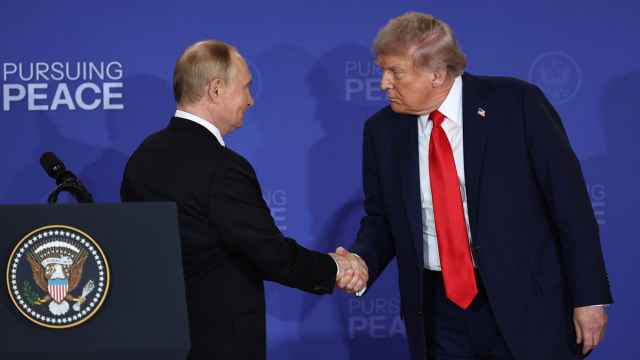In recent weeks, there has been a spate of reports again highlighting the rapid increase in U.S. oil and gas production, and the potential for much greater production to come over the next decade. Several of the reports have also alluded to the potential for significant shale gas production in Europe, but the main message is that the U.S. is set to become the predominant global energy powerhouse. Their conclusion is that the shale revolution is about to kill off Russia's growth and bring an end to the geopolitical swagger of President Vladimir Putin. A recent report on the subject, carried by the Washington-based think tank, Center for The National Interest, had the headline "Russia's Faltering Energy Empire." The message could not be clearer: Russia's Achilles' heel is energy, and the U.S. has it in its sights.
The impression many of these reports give is that Russia is critically dependent on hydrocarbon revenues — not only to fund the budget, but also to preserve social stability and popular support for the Kremlin. The reality, of course, is different, but these headlines and stories are still keeping far too many discretionary investors away from Russia because of the perceived risk posed by the development of shale in the U.S. and, eventually, in Europe.
Russia is no longer the world's largest gas producer and will probably within a year cede either the top or second placed spot in the oil industry. Currently, according to International Energy Agency, or IEA, data, Russia and Saudi Arabia are almost tied in terms of aggregate average daily oil production at about 10.8 million barrels per day, while the U.S. produces an average of 10.4 million barrels per day. The U.S. number is up from only 7.5 million barrels per day five years ago, while Russia's average output has gained only very modestly in that period.
According to IEA forecasts, by the middle of next year aggregate U.S. oil output is expected to top 11 million barrels per day, while Russia will likely have flatlined from today's average. Saudi Arabia's standing next year will depend on whether the current outages in Libya and Iraq have been restored or still have to be compensated for, but is also unlikely to be much above the current level.
In the gas sector, the reversal of positions between the U.S. and Russia has already been much more dramatic. Five years ago. the U.S. produced 570 billion cubic meters, or bcm, of gas annually, and last year that volume climbed to 680 bcm. Over the same period, Russia's production slid from 602 bcm to 592 bcm. Several U.S. forecasters expect the U.S. to produce between 800 and 880 bcm by 2030 and to dominate the global export market in liquefied natural gas.
Looking at those numbers, it is easy to see why so many reports have been predicting the end of Russia's period of growth and stability. This is damaging to efforts to attract a larger volume of long-term investment into the economy. Investors look for long-term growth stories and avoid those where the growth drivers are weak or perceived to be at risk of decline.
Several commentators, including myself, have long been highlighting the risk to the domestic economy posed by the rapid growth in U.S. shale oil and gas. It matters little whether Russia is the No. 1 oil or gas producer in the world or No. 10. What is more important is that oil and gas revenues still represent close to half of total federal budget revenues, while the nonenergy part of the budget is still running a deficit equal to about 11 percent of gross domestic product.
The message is not, as some industry managers have been calling for, that Russia now needs to invest heavily in developing its own shale resources, but that the country has a shrinking window within which to more rapidly push economic and industrial reforms. It is relatively easier to make significant changes in the economy and to initiate spending and incentive programs with oil averaging close to $110 per barrel than it would be if the price of oil where to collapse to, say, $60 per barrel because of an increased level of shale-based production.
This is also the message which the International Monetary Fund delivered in its recent annual review of the trends in Russia's economy. While sticking with a low forecast of only 1.5 percent growth for this year, IMF economists said they believed average annual growth of 5 percent might be achieved with faster progress in implementing its reform program. The IMF talked about the need to maintain a stable macroeconomic environment, to improve the business climate and investment attractiveness of the country and to pursue measures to boost productivity. This is a familiar list for sure.
But while we rightly focus on what more needs to be done to boost investment and to improve the business climate as part of the program to further reduce oil and gas vulnerability, it is worth reflecting on the fact that over the past 18 months, there has actually been more reform progress than seen over the previous decade. Russia's membership of the World Trade Organization just over a year ago has certainly not been without teething problems, but the terms of admission will prove to be an important catalyst for business reforms in the coming years.
There will be no other choice. The legislation to force state officials and bureaucrats to be more transparent with their income, and wealth is also an important step in fighting corruption. The fiscal rule, which caps the amount of oil wealth which can be spent, was a big step in budget reform. Putin's goal to move Russia up the ranking on the World Bank's Ease of Doing Business survey has already had some success as the recently released 2014 report showed an improvement from No. 111 last year to No. 92. This improvement in the ranking was due in large part to easier and fewer bureaucratic procedures to register property, open a new business, get hooked up to the electricity grid and get a construction permit. In addition, there have been significant financial market reforms, while the proposal to offer amnesty for many white collar criminals played a positive role as well.
Russia does not need to pursue shale oil or shale gas projects. It has an abundant supply of conventional hydrocarbons to maintain an adequate revenue stream for the budget, even with greater price volatility. It has no need to risk sitting on expensive shale projects if the price of oil and gas collapses as a result of a global supply increase. The pioneering U.S. producers may find themselves in that predicament before the end of this decade.
Russia has made great progress in reducing the vulnerability of the economy and the budget to oil and gas revenues over the past 10 years. Clearly, a lot more needs to be achieved, and the hope is that this can be done at an even faster pace than seen over the past 18 months. Let's hope a preoccupation with who is the biggest oil and gas producer does not prove to be a distraction. Size is not everything.
Chris Weafer is senior partner with Macro Advisory, a consultancy advising macro hedge funds and foreign companies looking at investment opportunities in Russia.
A Message from The Moscow Times:
Dear readers,
We are facing unprecedented challenges. Russia's Prosecutor General's Office has designated The Moscow Times as an "undesirable" organization, criminalizing our work and putting our staff at risk of prosecution. This follows our earlier unjust labeling as a "foreign agent."
These actions are direct attempts to silence independent journalism in Russia. The authorities claim our work "discredits the decisions of the Russian leadership." We see things differently: we strive to provide accurate, unbiased reporting on Russia.
We, the journalists of The Moscow Times, refuse to be silenced. But to continue our work, we need your help.
Your support, no matter how small, makes a world of difference. If you can, please support us monthly starting from just $2. It's quick to set up, and every contribution makes a significant impact.
By supporting The Moscow Times, you're defending open, independent journalism in the face of repression. Thank you for standing with us.
Remind me later.







